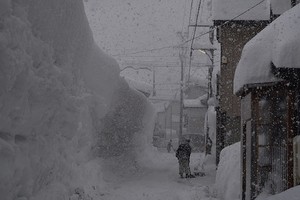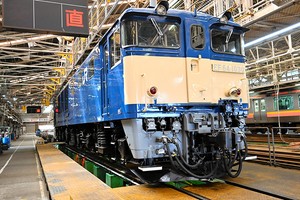August 26, 2022 at 13:42 JST
 Kansai Electric Power Co.’s Mihama nuclear power plant in Mihama, Fukui Prefecture (The Asahi Shimbun)
Kansai Electric Power Co.’s Mihama nuclear power plant in Mihama, Fukui Prefecture (The Asahi Shimbun)
Prime Minister Fumio Kishida’s proposal to start expanding nuclear power generation again is a rash move to make a major energy policy shift under the pretext of overcoming the current “energy crisis.”
Kishida should rethink the proposal, which is certain to create serious problems for the nation’s future.
Kishida recently said his administration will consider building new reactors and expanding or rebuilding the existing nuclear plants while also weighing an extension of the legal reactor lifespan of 40 years.
His proposal clearly indicates the government’s intention to return to promoting nuclear power generation and represents the biggest energy policy change since the catastrophic accident at the Fukushima No. 1 nuclear power plant in 2011.
The accelerating global trend toward a carbon-free future and the threat of an energy crisis engendered by Russia’s invasion of Ukraine make it necessary for policymakers to consider ways to secure a stable power supply.
But the policy response to the challenge should not be one that disregards the vital lessons learned from the Fukushima disaster.
We urge the Kishida administration to preclude a policy option that would prolong and deepen the nation’s dependence on atomic energy.
HAS JAPAN FORGOTTEN LESSONS FROM FUKUSHIMA?
The accident that began to unfold on March 11, 2011, led to an unprecedented crisis of triple reactor core meltdowns, causing tremendous social and economic damage.
The calamity forced residents of areas around the stricken nuclear plant to leave their homes and generated profound anxiety in the entire Japanese society.
Even now, many people are being forced to live as evacuees without receiving sufficient compensation. It is completely unclear when the cleanup work including decommissioning the ruined reactors will be complete.
The safety standards for nuclear plants have been strengthened in response to the disaster. Still, building nuclear plants in Japan, a nation prone to such natural disasters as earthquakes, tsunami and volcanic eruptions, entails much higher risks than in other countries.
Nuclear power generation is an incomplete system for Japan, which has no final disposal site for high-level radioactive waste. High-level nuclear waste remains highly radioactive and extremely hazardous for tens of thousands of years before its radiation levels decline sufficiently.
There is no site in Japan where such radioactive waste can be disposed of in such a manner that it can be securely isolated for an unimaginably long period of time.
Plutonium contained in spent nuclear fuel can be used to make nuclear weapons and must be stored and managed strictly under international rules.
Japan has promised to reduce its stockpile of plutonium. But its project to develop fast-breeder reactor technology to use plutonium as fuel has fallen through despite massive government spending.
Given the bitter past experiences and the raft of tough challenges for nuclear power generation, it is clear that reducing our society’s dependence on nuclear power gradually, if not ending it altogether immediately, is the only reasonable and realistic choice.
This view has apparently been behind the government’s pledge to lessen the nation’s dependence on atomic energy and its policy of ruling out the construction of new reactors or expanding existing plants.
It is questionable how seriously Kishida has considered the lessons from the accident and the formidable challenges facing nuclear power generation as he ordered these new proposals to be considered. There is no convincing case for taking the step.
QUESTIONABLE DECISION-MAKING PROCESS
The way the policy change was proposed and discussed is also open to dispute.
Kishida made the announcement in the second meeting of the government’s GX (green transformation) Implementation Council. During the council’s first meeting in July, Kishida ordered a list of policy measures that demand political decisions, and the ministry of trade and industry and other organizations involved compiled the list.
The council’s members include business leaders and power industry executives supporting the promotion of nuclear power generation and hold discussions behind closed doors. In contrast to the expert panel that is discussing the government’s basic energy plans openly, this council falls short on diversity and transparency.
It is inappropriate of the government to propose and discuss a radical change in a policy that is deeply linked to people’s lives at this council.
Before the July Upper House election, Kishida did not give any clear answer to the question of whether he was mulling over the possibility of building new reactors or expanding existing facilities.
Soon after the election, he started considering the idea and calling for a conclusion by the end of the year. This is a policymaking process that is far from democratic.
Moreover, there is no established technology for building new reactors. Proposed small-size reactors are still under development, while the fast-breeder reactor project is now up in the air.
There is no clear vision, either, for what the government calls a “next-generation innovative reactor,” presumably designed to be a safer reactor based on current technology. Kishida himself has admitted that it will take time to turn some of these ideas into a reality.
Nuclear power generation does not make economic sense, either. Electricity generated by a new reactor built in 2030 will be costlier than power generated by a solar power system for business use, according to the latest estimate by the ministry of trade and industry.
There are also risks involved in the early stages of the development of new reactor technology.
SAFETY REGULATIONS MUST NOT BE UNDERMINED
Referring to such unreliable technologies as a means to ensure a stable power supply for the time being amounts to trying to pull the wool over someone's eyes.
If the government opts to bring the nation back to expanding nuclear power generation, allowing it to fall behind other major industrial nations in the global race to develop new renewable energy technologies, Japan’s international competitiveness will further decline.
The list of proposals Kishida ordered to be considered includes extending the operational life span of nuclear reactors and mobilizing all the resources of the parties involved to restart offline reactors. Kishida said the government should take the initiative and make every possible effort to bring idled reactors back on stream.
We can understand his remarks if they mean the government will try to ensure that electric utilities operating nuclear plants comply with the advice and instructions from the Nuclear Regulation Authority.
We can also support his stance if that means the government is committed to taking responsibility for the safe evacuations of residents around nuclear plants in the event of serious accidents and responding sincerely to questions about the risks of accidents.
But the government must not be allowed to apply any political pressure on reviews and inspections that must be scientifically strict or the process of making decisions through winning the consensus of local communities involved.
One major lesson from the Fukushima nuclear disaster is the vital importance of respecting the decisions by local governments that host nuclear power plants and the independence of the NRA.
Russia’s aggression against Ukraine, which was used as a pretext for the policy change, has underscored the risk of armed attacks on nuclear facilities. Obviously, Russia’s brutal invasion must not be tolerated.
But the reality is that the danger of Japan operating many nuclear plants in its narrow territory is only growing.
There should be no doubt that a simple return to nuclear power is not the answer to the tough and complicated challenge of securing a stable power supply for the nation under the current situation.
The Asahi Shimbun, Aug. 26




















A peek through the music industry’s curtain at the producers who harnessed social media to help their idols go global.
A series based on diplomatic documents declassified by Japan’s Foreign Ministry
Here is a collection of first-hand accounts by “hibakusha” atomic bomb survivors.
Cooking experts, chefs and others involved in the field of food introduce their special recipes intertwined with their paths in life.
A series about Japanese-Americans and their memories of World War II